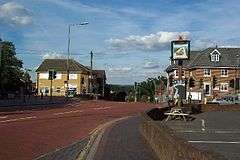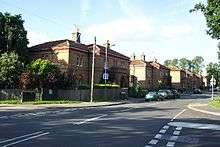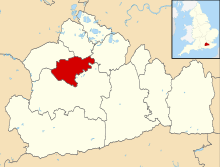Knaphill
| Knaphill | |
|---|---|
 Knaphill high street | |
 Knaphill Knaphill shown within Surrey | |
| Population | 8,635 [1] |
| OS grid reference | SU965587 |
| District | |
| Shire county | |
| Region | |
| Country | England |
| Sovereign state | United Kingdom |
| Post town | Woking |
| Postcode district | GU21 |
| Dialling code | 01483 |
| Police | Surrey |
| Fire | Surrey |
| Ambulance | South East Coast |
| EU Parliament | South East England |
| UK Parliament | |
Knaphill is an urban village in Surrey, England. To the east is Woking, to the west is Aldershot, while to the south and north on the A322 – which forms its effective western border – are Brookwood, and Bisley, respectively. Some of the village is set on a hill, hence the name. Knaphill has a cricket team formed in 2015. The team's home games are played at Waterers Park with an annual charity match in August. The club play against local teams such as Brookwood CC and Byfleet CC.
History
The village name was first recorded in 1225 as La Cnappe. Since then there have been various spellings of the name including 'Nap Hill, Naphill and Knap Hill.
In 958 A.D., the village was probably part of land granted to Westminster Abbey; there is clear ownership by 1278. The land passed to Henry VIII on the dissolution of the monasteries in the 1530s.
The Basingstoke Canal was built to the south of Knaphill in 1794 and the railway line came in 1838. In 1859, a prison was built in Knaphill. This was later converted into army barracks.[2]
Today
Knaphill is also the home to three schools: Knaphill Lower School, Knaphill Junior School and St John's Primary School. Furthermore, Peer Productions, a large theatre company, is based at the Woking Youth Arts Centre in Knaphill. It provides dramatic education for students of all ages. WYAC was previously known as Trinity Studios, and is famous as being the birthplace of the Spice Girls and the boy band 5ive
The local pub Hooden takes a Knap has been changed back to its original name The Garibaldi. There are several other pubs in Knaphill, including The Royal Oak which dates back to the 17th century on Anchor Hill,The Anchor formerly a hotel and Crown in the high street. The village has a residents' association.[3] The nearest railway stations are at Brookwood and at Woking.
Sport and leisure
Knaphill has a Non-League football club Knaphill F.C. who play at 'Redding Way', The Brookwood Country Park Football Ground
Knaphill has a Cricket Club who play at Waterers Park and was established in 2015. The club welcome's people to play for their team aged 16+ and of all abilities. Knaphill had a Men's team up till early 90s - a New team was formed around 25yrs later in 2015. Up until the late 1930s Knaphill also has a female team.
Knaphill is home to Mizens Railway, a 7 1/4 in gauge railway run by volunteer members of the Woking Miniature Railway Society (WRMS). It is open most summer Sundays from 2pm until 5pm.
Brookwood Hospital
One of the major employers in the area until its closure in the 1990s was Brookwood Hospital, a vast, rambling mental hospital that dated from the late Victorian era. Built on land formerly known as Knaphill Common, the hospital started life as The Surrey Asylum and formed part of the southern boundary of Knaphill (being denoted by the Basingstoke Canal).
Its name was changed to Brookwood Hospital in 1919 to make it easier for patients and visitors travelling by rail to Brookwood Station to locate. Most of the hospital grounds have now been redeveloped, the wards having made way for several superstores and a large number of houses. The central building, which is listed, has been retained and converted into luxury flats. Several of the new residential roads were named after the old hospital wards.
Inkerman Barracks

In 1859 the Home Office began constructing a prison for disabled convicts on a 65-acre site in Knaphill. Woking Convicts Prison received its first male inmates the following year (construction was still ongoing and the convicts took over much of the work). By 1870 there was both a men's and a women's prison on the site, accommodating 613 inmates between them.
In the 1890s, however, the prisoners were moved out to make room for the Army and the site was renamed Inkerman Barracks. A variety of regiments were accommodated over the ensuing years and during World War I the barracks served as a military hospital. After the Second World War it became a depot for the Royal Military Police. In the 1970s, however, the site was sold to Woking Borough Council and comprehensive demolition followed; a couple of terraces of houses are all that remain today.[4]
See also
References
- ↑ Census
- ↑ Local history
- ↑ Knaphill Residents' Association
- ↑ "Inkerman Barracks" (PDF). Royal Military Police Association. Retrieved 12 May 2017.
External links
![]()
